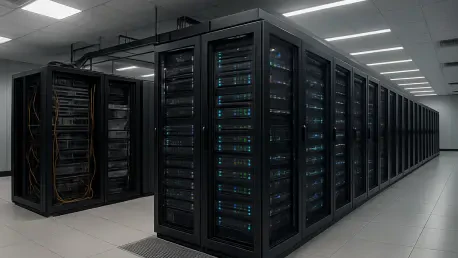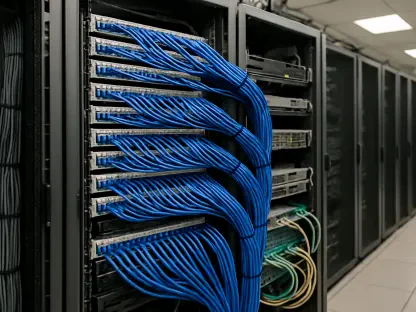Setting the Stage for Modern Data Challenges
In an era where digital transformation dictates business success, the staggering growth of data—expected to reach unprecedented volumes in the coming years—poses a monumental challenge for organizations worldwide, and data centers, the backbone of this digital ecosystem, are under immense pressure to handle escalating workloads while maintaining efficiency and reliability. Many facilities, built on outdated infrastructure, struggle to keep pace with these demands, leading to skyrocketing energy costs and performance bottlenecks. This review delves into the realm of data center modernization, exploring innovative strategies that promise to revitalize these critical hubs without the prohibitive costs and disruptions of traditional overhauls. The focus is on practical, scalable solutions that can redefine how organizations manage their IT infrastructure.
Analyzing Modernization Strategies
Hybrid Cloud Architecture: Balancing Control and Flexibility
Hybrid cloud solutions stand out as a transformative approach, blending the security of private infrastructure with the scalability of public cloud services. This model allows organizations to offload peak workloads or deploy new applications seamlessly, reducing the need for extensive physical upgrades. Its appeal lies in cost-effectiveness, enabling businesses to scale operations dynamically without over-investing in on-premises hardware.
Beyond scalability, hybrid cloud architectures offer a strategic advantage by maintaining control over sensitive data while leveraging external resources for less critical tasks. This balance minimizes operational risks and ensures compliance with stringent regulations. For many, this approach represents a pragmatic step toward modernization without abandoning existing investments.
Efficient Hardware Upgrades: Powering Performance
Another compelling strategy involves upgrading to energy-efficient servers and equipment, directly tackling the pervasive issues of power consumption and cooling demands. Modern hardware often delivers superior performance with a smaller energy footprint, addressing bottlenecks without necessitating a full infrastructure revamp. This method proves less invasive, allowing facilities to enhance capabilities with minimal downtime.
The benefits extend to long-term savings, as reduced energy usage translates to lower operational costs. Additionally, newer equipment generates less heat, easing the burden on cooling systems and extending the lifespan of other components. This targeted upgrade path is particularly suited for organizations constrained by budget or space limitations.
Layout Modifications: Optimizing Physical Space
Reconfiguring the physical layout of a data center, such as adopting hot aisle/cold aisle designs, offers a surprisingly effective way to boost cooling efficiency. By strategically arranging equipment to separate hot and cold air streams, facilities can reduce energy waste and improve overall performance. Such modifications typically involve minimal disruption compared to systemic retrofits.
These changes often yield immediate results, enhancing airflow management and cutting down on cooling expenses. For data centers operating in tight quarters, layout adjustments provide a low-cost avenue to squeeze more efficiency from existing setups. This approach underscores the value of smart design in addressing operational challenges.
Server Rack Replacement: Enhancing Support Structures
Upgrading to modern server racks presents a budget-friendly tactic to optimize space and improve functionality. Newer racks are designed to support more devices, enhance airflow, and bolster security features, addressing multiple pain points in one fell swoop. This solution focuses on maximizing the potential of current infrastructure without extensive overhauls.
The simplicity of rack replacement makes it an attractive option for facilities seeking quick wins. Improved organization and accessibility also contribute to easier maintenance and scalability. As a standalone measure or part of a broader strategy, this upgrade delivers tangible benefits with limited investment.
Modular Data Centers: Incremental Expansion
Modular data centers emerge as a forward-thinking solution, offering self-contained units equipped with integrated power and cooling systems. These portable setups allow organizations to expand capacity incrementally, aligning growth with demand rather than overbuilding upfront. Their design inherently prioritizes efficiency over legacy systems.
Integration with existing facilities is a key strength, enabling seamless scaling without disrupting core operations. For businesses anticipating gradual increases in data needs, modular units provide a flexible, cost-efficient alternative to traditional construction. This adaptability positions them as a cornerstone of modern infrastructure planning.
Full Cloud Migration: A Radical Shift
For some organizations, decommissioning physical infrastructure in favor of full cloud migration marks a bold yet viable path. This strategy eliminates the need for on-site maintenance, shifting operations entirely to cloud environments. However, it demands careful evaluation of compliance, security, and performance requirements to ensure suitability.
While offering unparalleled flexibility and reduced overhead, this approach may not fit every scenario, especially for workloads requiring low latency or strict data sovereignty. Nonetheless, for businesses ready to embrace a cloud-centric model, the potential for transformation is immense, redefining operational paradigms in the process.
Emerging Trends Shaping the Landscape
The trajectory of data center modernization is increasingly influenced by a blend of hybrid and cloud-based solutions, reflecting a broader shift toward flexibility in IT management. Organizations are prioritizing strategies that allow seamless integration of external resources while preserving critical on-site capabilities. This trend highlights a growing preference for adaptability over rigid, capital-intensive upgrades.
Another significant movement is the emphasis on incremental improvements, where smaller, targeted adjustments yield substantial efficiency gains. From hardware refreshes to layout tweaks, these efforts demonstrate that modernization need not be an all-or-nothing endeavor. The focus remains on balancing immediate operational needs with scalability for future growth.
A deeper focus on sustainability is also reshaping strategies, with energy-efficient designs and automation gaining traction. As environmental concerns mount, data centers are under scrutiny to minimize their carbon footprint through innovative technologies. This convergence of efficiency and responsibility is poised to define the next wave of advancements in the field.
Real-World Impact Across Industries
Across diverse sectors, modernization strategies are proving their worth in tangible ways. In finance, hybrid cloud architectures enable firms to handle fluctuating transaction volumes while safeguarding sensitive data, ensuring both agility and compliance. This dual capability has become indispensable for maintaining competitive edges.
Healthcare organizations, grappling with vast data from patient records and research, are turning to modular data centers to scale storage and processing power without overhauling facilities. Meanwhile, e-commerce giants leverage full cloud migration to support massive seasonal spikes, demonstrating the transformative potential of offloading physical constraints. These varied applications underscore the versatility of modernization approaches in addressing industry-specific demands.
Navigating Challenges and Limitations
Despite the promise of alternative strategies, modernization efforts are not without hurdles. Technical complexities often arise when integrating new systems with legacy infrastructure, requiring specialized expertise to avoid pitfalls. Budget constraints further complicate decisions, forcing organizations to prioritize certain upgrades over others.
Regulatory compliance adds another layer of difficulty, particularly for industries handling sensitive data under strict guidelines. Operational disruptions, even with less invasive methods, remain a concern, necessitating meticulous planning to minimize impact. Addressing these challenges demands a blend of innovation and strategic foresight to ensure smooth transitions.
Reflecting on the Path Forward
Looking back, this exploration of data center modernization revealed a spectrum of viable alternatives to traditional retrofitting, each tailored to unique organizational needs. Hybrid cloud solutions, hardware upgrades, and modular expansions stood out for their ability to deliver efficiency and scalability with minimal disruption. The journey through real-world applications and emerging trends underscored the adaptability of these strategies across diverse contexts.
As a next step, organizations should assess their specific constraints—be it budget, space, or compliance—and align modernization efforts with long-term digital goals. Partnering with technology providers to pilot incremental changes can mitigate risks while building confidence in broader transformations. Additionally, staying abreast of advancements in automation and sustainable design will be crucial to maintaining relevance in an ever-evolving landscape. The road ahead offers ample opportunity to redefine data management through thoughtful, strategic action.









